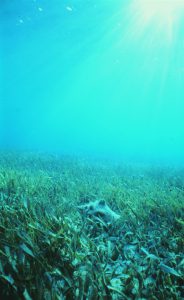
Queen Conch (current scientific name Alger gigas, formerly Strombus gigas) is such an iconic animal in the Florida Keys that local born residents are called “conchs,” especially those living near Key West, Florida. Most locals have their own recipes for conch salad (aka conch ceviche) and conch fritters. On New Year’s Eve, a famous local establishment drops a giant lighted conch shell during the end-of-year countdown on Duval Street. Queen Conchs are one of the largest gastropod mollusks that live in warm tropical waters throughout South Florida to Bermuda, in the Gulf of Mexico and the Caribbean — growing up to 12 inches long and a weight of 5 pounds. It takes 3 to 5 years to grow to their full length, and then they live the rest of their days thickening the shell, especially the “lip” that flares out on the side. An animal with a thick, well-flared shell indicates a sexually mature adult. These giant sea snails are herbivores and spend their time feeding on algae and plant detritus and avoiding Florida’s State Shell — the Horse Conch Triplofusus giganteus. The Horse Conch is a large carnivorous snail that is up to two feet long and eats other snails and clams. Oftentimes when you find a Horse Conch, it will have a smaller Queen Conch wrapped inside its large bright orange foot.
Queen Conchs can live for more than 30 years. Since they live in clear, shallow waters and are very slow moving (like all snails!) they are easily captured for food and seashell souvenirs. The Queen Conch fishery has been overharvested in many areas throughout their range. In Florida, the Queen Conch commercial fishery has been closed since 1975 and the recreational harvest has been closed since 1985 in state waters (1986 in federal waters). Yet despite 30 to 40 years of no legal harvest in the United States, Queen Conch populations continue to remain very low. With the proper fishing licenses, Queen Conch still has a legal commercial and recreational harvest in many areas of the Caribbean, including the Bahamas, St. Croix, and Puerto Rico. Queen conch is available for purchase at local grocery stores and restaurants. Honduras is considered to have the most sustainable conch fishery in the Caribbean.
Proposed Rule to list Queen Conch as Threatened Under the Endangered Species Act
In September 2022, NOAA Fisheries released a notice to list the Queen Conch under the Endangered Species Act. NOAA Fisheries is looking for public comment on the Federal Register until December 15, 2022.
Endangered Species Act Definitions
- Endangered – any species which is in danger of extinction throughout all or a significant portion of its range
- Threatened – any species which is likely to become an endangered species within the foreseeable future throughout all or a significant portion of its range (South Florida, Bermuda, Caribbean)
For more information, NOAA Fisheries has provided the Endangered Species Act Status Review Report for Queen Conch.
 4
4
